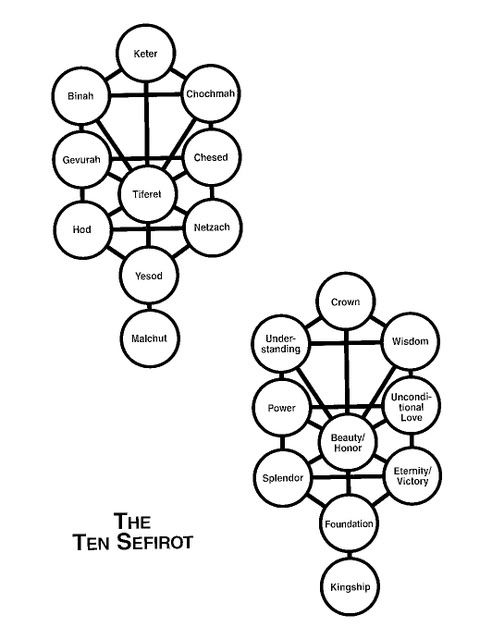Basically, you always have Keter at the top and Malkhut (manifestation, or kingship - it can be either)at the base, but some versions shuffle the ones between around a LITTLE (not too much). Here's a link to numerous versions - I invite you to take a look and start to become familiar with the names of the ten sefirot:
h**ps://
www.google.com/search?q=images+sefirot& ... 22kD85M%3A
Frankiel now tells us she will discuss the Tree from two perspectives. First, from top to bottom -
how the divine energies transform and manifest themselves, proceeding from God's emanation of divine light to the world as we know it.
That's Part II of the book: The Unfolding of Creation
Part III will
'describe the sefirot as also the "Path of Remembering"...This mode of understanding will take us on a more circuitous route, beginning at the bottom of the diagram and moving up the tree in terms of stages of development, but also spiraling through the sefirot to indicate their interrelationships. Ultimately, this process will bring us into the depths of our hearts, where we unify our human selves with the Divine
' (Heavy stuff!)
Now there's a chart with all the names, the Hebrew and English translation, the part of the body each sefirot relates to (I should add that) and the 'meaning' or explanation of the meaning of each.
name: translation: body part: meaning
Keter: Crown: crown of the head: divine spark, will, or soul
Chochma: Wisdom: right temple: first emanation of light, spark of inspiration, seed of thought
Binah: Understanding: left temple: nourishing the spark into a flame
Da'at (replaces Keter, which can't be described apparently): knowledge: brain stem and spinal cord: (also 'the eleventh sefirot') unifying and connecting knowledge (chochma and binah generate da'at)*
Chesed: expansiveness: right shoulder and arm: lovingkindness, divine grace and support
Gevurah: restraint: left shoulder and arm: discipline, limitation, strength of character
Tiferet: splendor: heart and solar plexus: harmonic balance of tendencies (it is 'tiferet' that bolts everything else together) - kind of like mindfulness?
Netzach: perseverance: right hip and leg: energetic initiative, stamina
Hod: surrender: left hip and leg: acceptance, yielding
Yesod: foundation: womb/genitals: processing and transmitting the energies of the preceding sefirot - kind of like the control station
Malkhut: manifestation: feet and (for some reason) lips: Kingship, Shekhinah (the manifestation of God in this world) the final impression made on the physical world, the divine presence immanent in the world.
*Chabad is the name of the outreach arm of Lubavitch Hasidim. There are Chabad houses and emissaries all around the world, doing outreach to all Jews to bring them back to 'yiddishkeit' (Jewishness, Judaism, being Jewish). Chabad is an acronym for Chochmah, Binah, Da'at: wisdom, understanding, knowledge.
Just thought I'd throw that in.
History is the fiction we invent to persuade ourselves that events are knowable and that life has order and direction. That's why events are always reinterpreted when values change. We need new versions of history to allow for our current prejudices.
